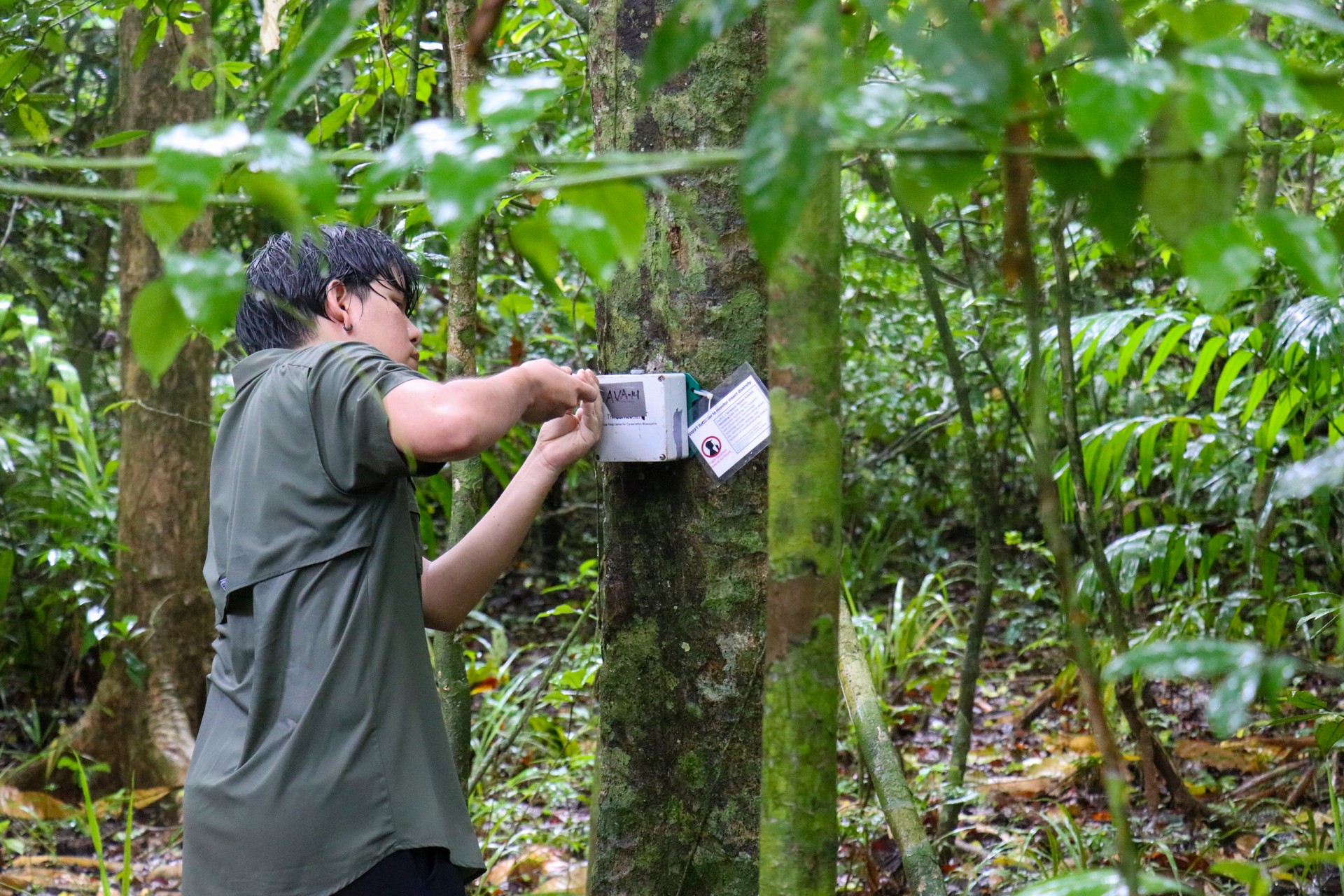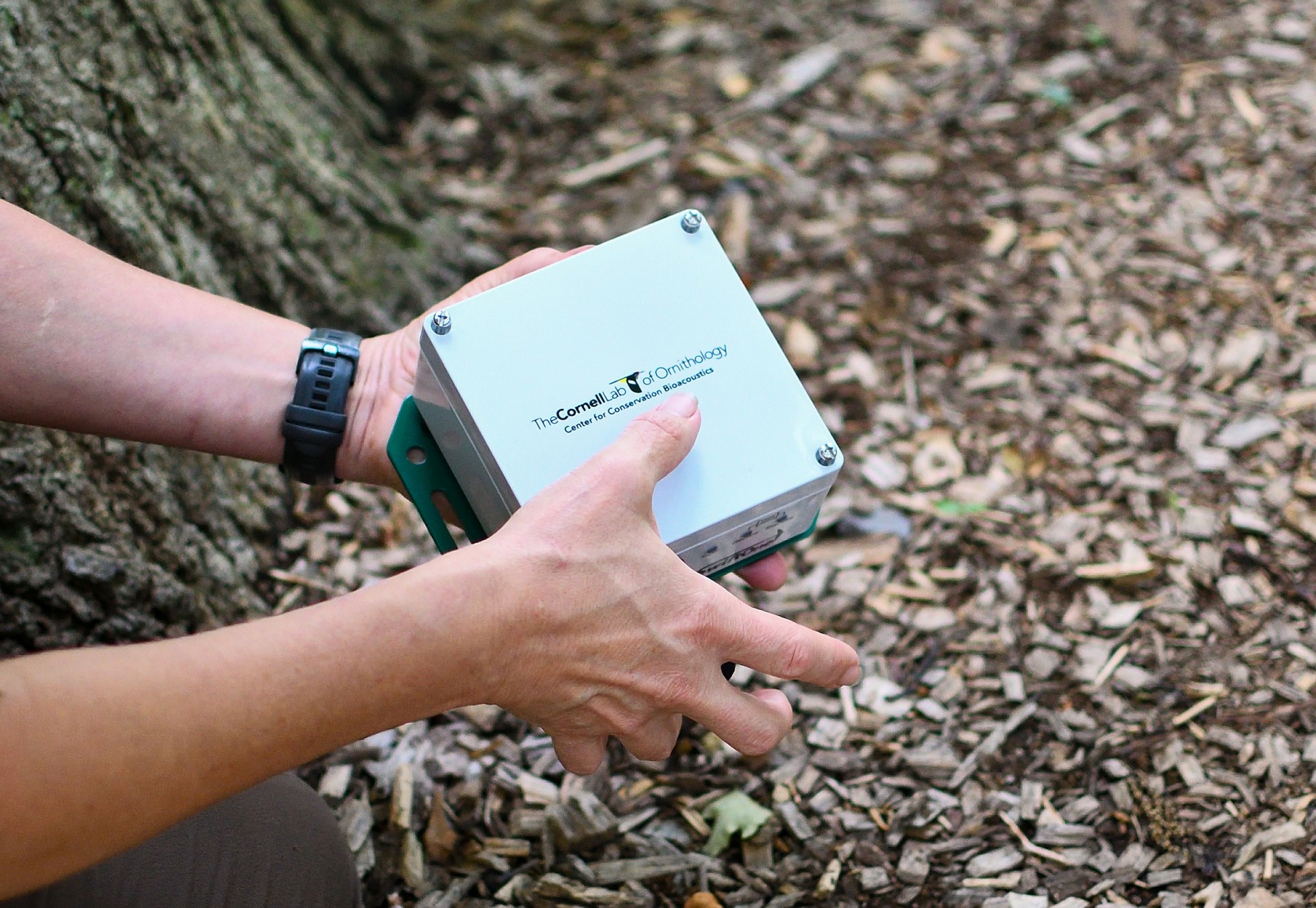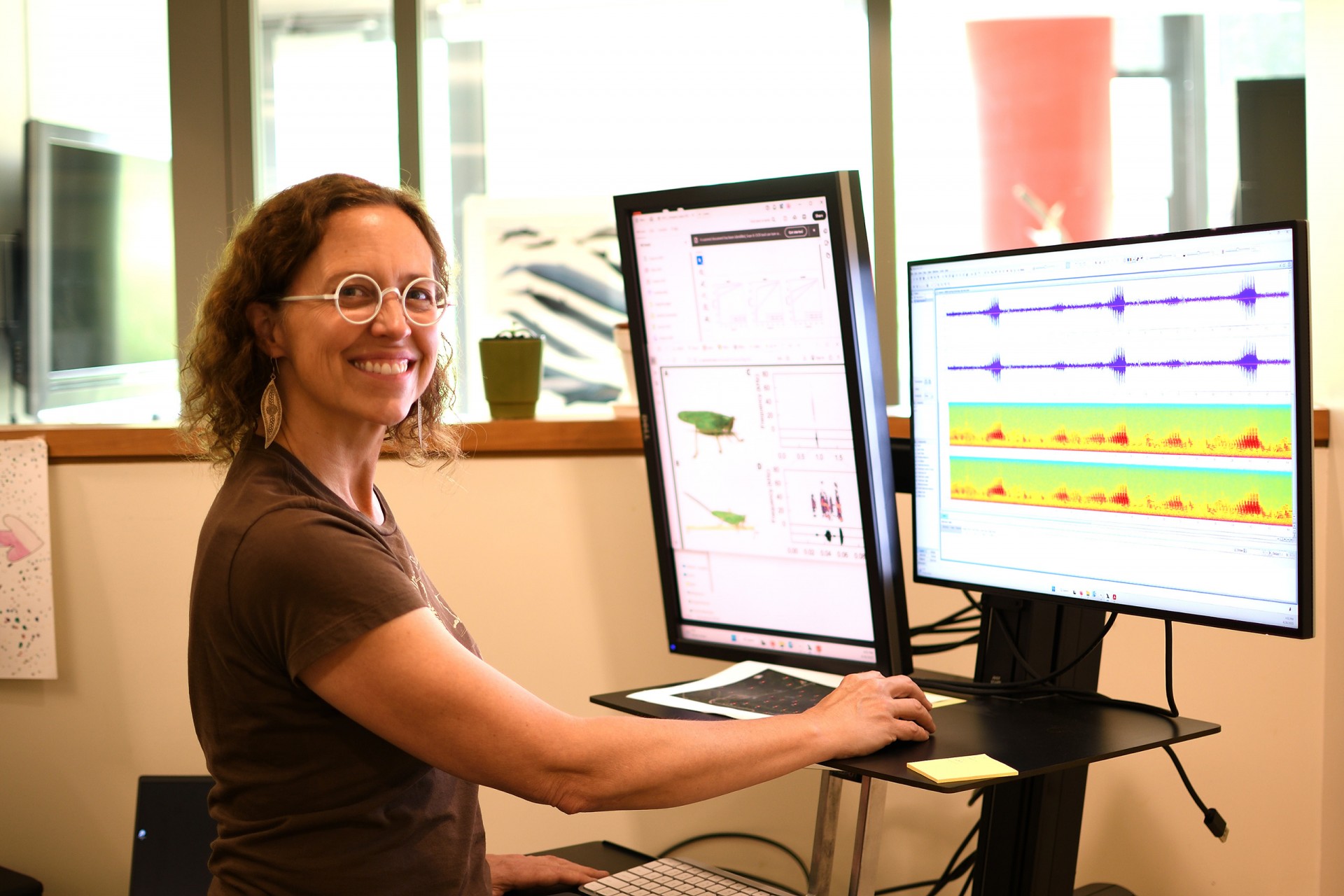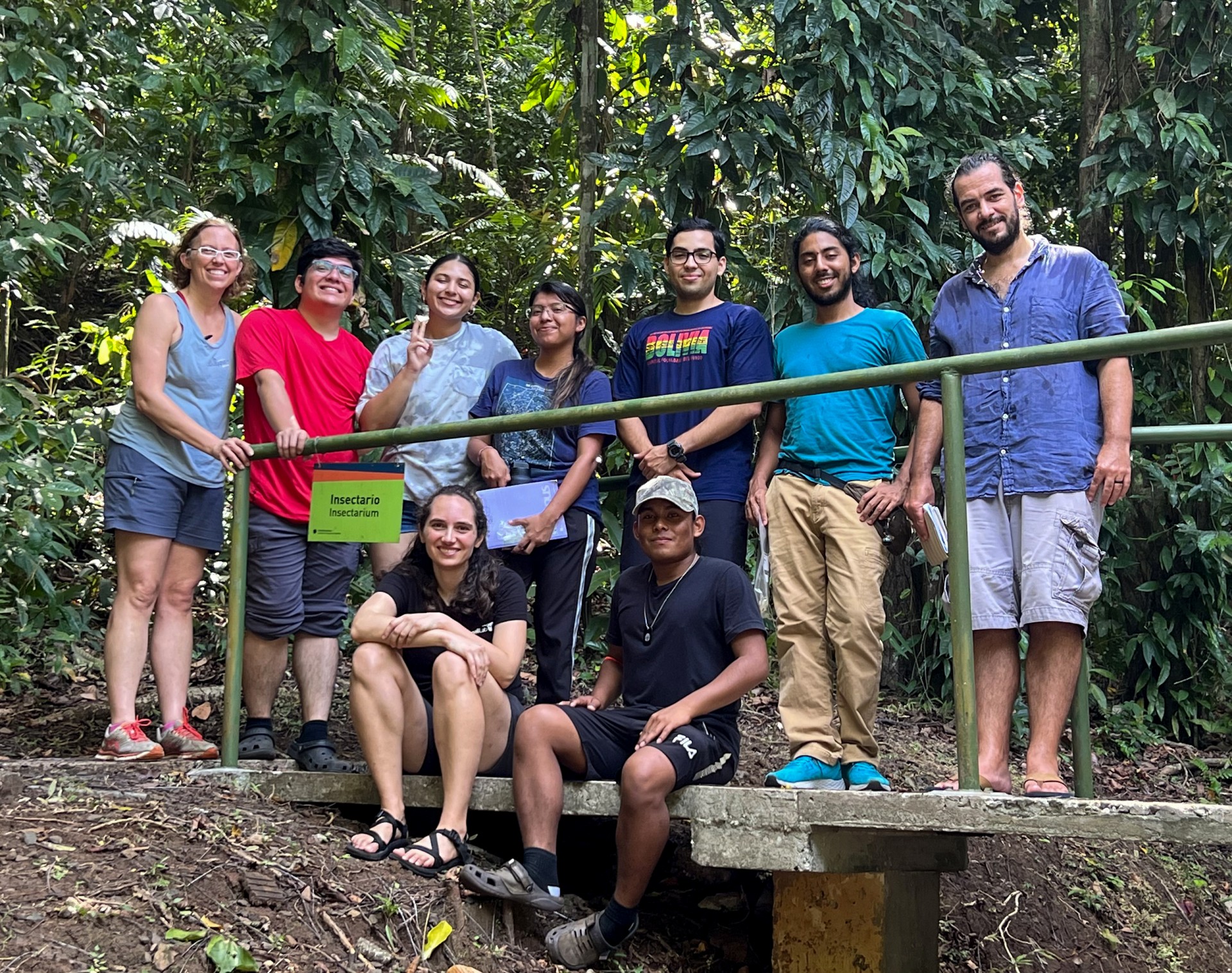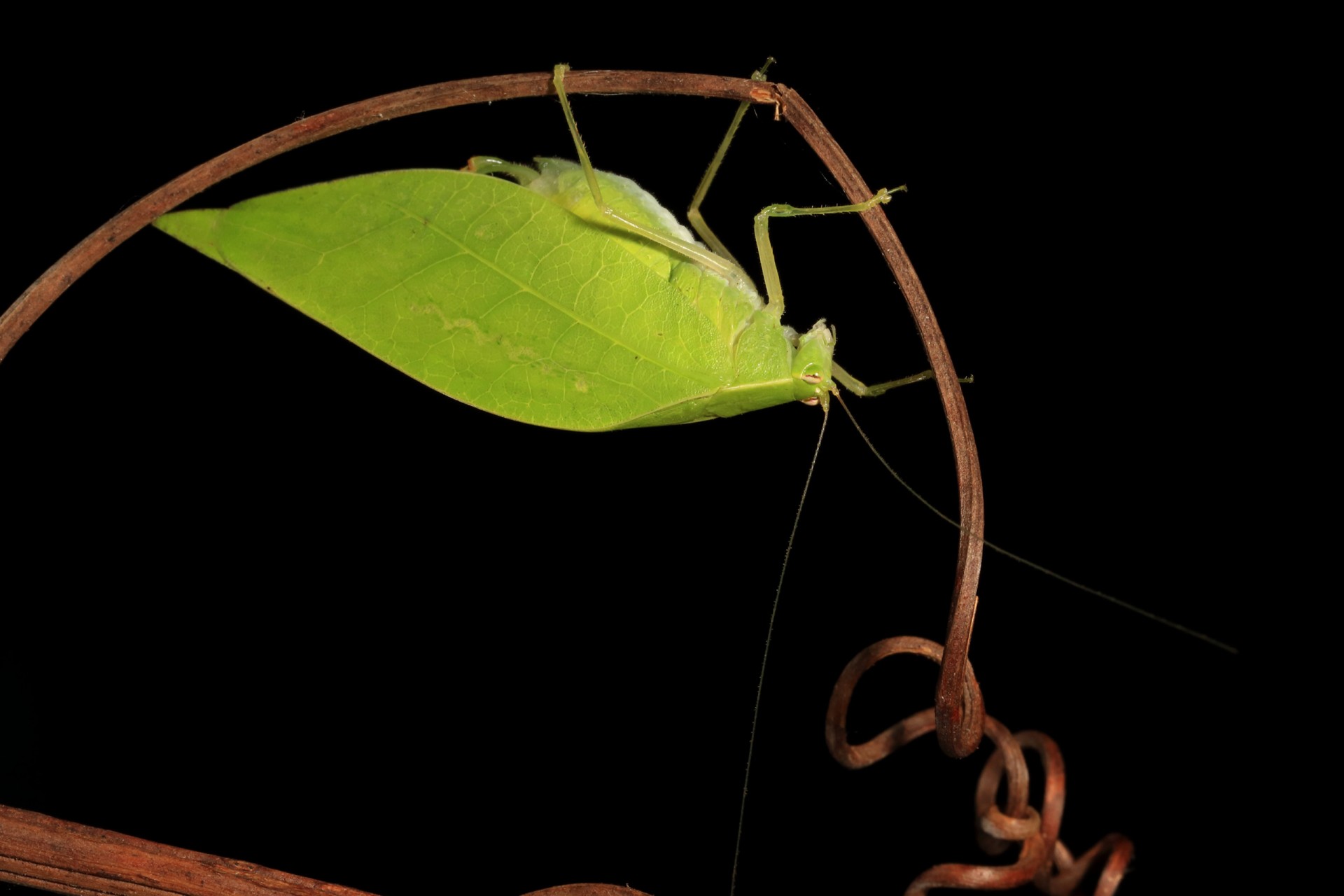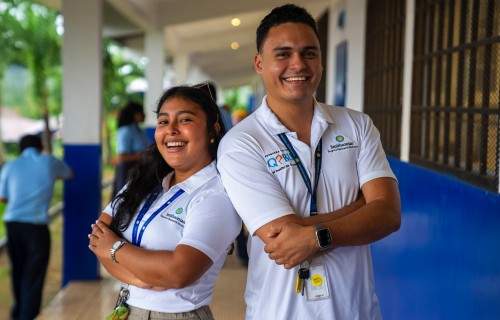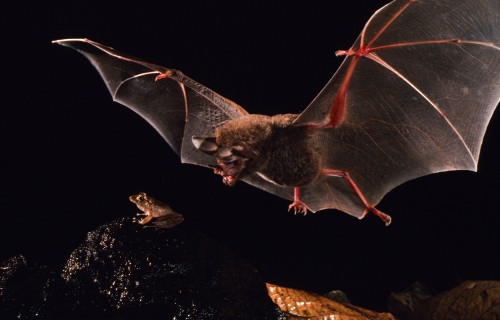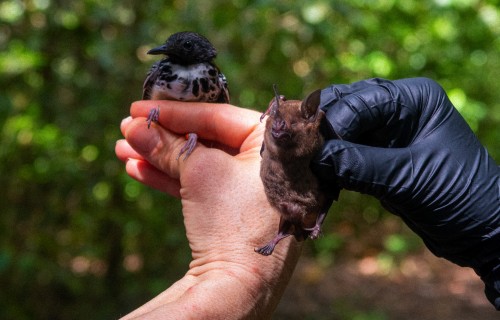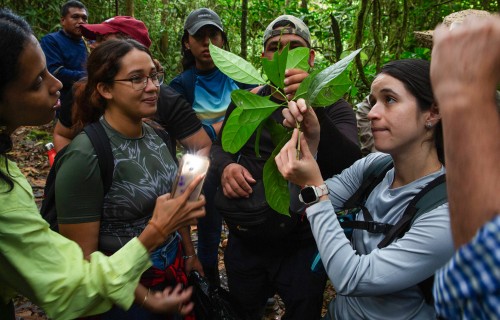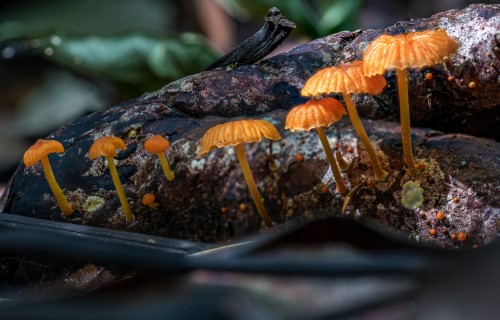Upwelling and Panama’s rich Pacific shores (Public talk in Spanish)
From Sound
to Science
How katydid songs expand
researchers’ knowledge of
tropical insects
By: Fern Alling
Scientists at the STRI Arthropod Lab collaborate with researchers at Cornell’s K. Lisa Yang Center for Conservation Bioacoustics to use sound to monitor insect populations on Barro Colorado Island.
I smell awful.
I spent the day following a team of entomologists with the Smithsonian Tropical Research Institute (STRI)’s Arthropod Lab. The rain, mud and sweat I’ve accumulated while trudging through the institute’s Barro Colorado Island research station is creating a scent I can practically see coming off of me in a cloud.
But if it’s reaching research assistant Miguel Youngs, he’s polite enough to pretend he can’t smell it. I’m hovering over his shoulder, watching as he performs routine maintenance on an instrument called the Swift. He unscrews a panel on the front of a small box strapped to a tree and swaps out three chunky Duracell D batteries and an SD card before carefully reassembling the device. While he puts the finishing touches on the unit, I glance underneath it and spot a small green bug sitting directly on its microphone.
Research assistant Miguel Youngs unscrews the front panel of one of the STRI Arthropod Lab’s Swift bioacoustics recorders. Members of the Arthropod Lab visit the monitoring stations Barro Colorado Island every two weeks to keep the recorders in working order.
Credit: Fern Alling
“They usually hang out there,” Youngs said, smiling. “It’s not a problem.”
The Swift is a bioacoustic monitoring tool built by the Cornell Lab of Ornithology that allows busy researchers at the Arthropod Lab to gather more data on the island’s bugs with relatively little effort.
After Youngs removes the SD card containing the recordings, they’ll be sent to bioacoustics experts at Cornell’s K. Lisa Yang Center for Conservation Bioacoustics. Together, Cornell and STRI scientists are building a sound library that can improve insect monitoring worldwide.
Every 15 minutes, the Swift’s microphone records three minutes of forest audio – regardless of any visitors that might be sitting on it. The frequencies the unit picks up are geared for orthopterans, a group of sound-producing insects that includes crickets, katydids and grasshoppers. Each species’ unique song comes from the way it stridulates or rubs parts of its body together. Some create a buzzing sound by scraping a row of fine bumps on their wings, not unlike scraping the files of a comb. Others chirp by doing the same with their hind legs. But regardless of how it’s made, the orthopteran calls we hear are all from males putting themselves out there in hopes of securing a mate.
Martinson holds one of the ten Swift recorders that the Arthropod Lab is using on Barro Colorado Island.
Credit: Ashik Rahaman, Cornell
“The crazy thing about the insects that I work with is that I’ve actually never heard most of them,” said Sharon Martinson, a postdoctoral research associate at Cornell with over a decade of experience studying insect bioacoustics. “I can’t because their songs are up in the ultrasonic part of the spectrum.”
Although the data sent to Cornell is auditory, researchers like Martinson use software to visually determine whether the wavelengths they’re looking at are actually orthopteran calls. When Martinson wants to see if a particular species was singing during a recording, she uses a machine learning algorithm that scans the recording and pulls out clips that closely match the target species. She must then double-check each clip to make sure the algorithm got it right.
Sharon Martinson, a Cornell Postdoctoral research assistant at the K. Lisa Yang Center for Conservation Bioacoustics, analyzing recordings of katydid calls. Martinson is an ecologist with 25 years of experience working with insects, and over a decade of bioacoustics research.
Credit: Ashik Rahaman, Cornell
But in order for the software to successfully search for orthopteran songs, it needs to be trained on what the songs actually sound – or look – like. Martinson worked with Laurel Symes, (Center for Conservation Bioacoustics, assistant director), Rachel Page (STRI staff scientist), Hannah ter Hofstede (Professor, University of Windsor, Ontario, Canada), and many other scientists and assistants to build a sound library for 50 katydid species on Barro Colorado Island. Yet after nearly a decade of work, there were still many insect sounds missing from their collection.
That’s why Greg Lamarre, a research associate at the Arthropod Lab, built an insect recording booth on Barro Colorado Island. Lamarre estimated there are more than 200 orthopteran species on the island, making the 50 katydids Martinson recorded a fraction of the total. So assistants with the Arthropod Lab visited the island as part of a year-long effort from Feb. 2024 to Feb. 2025, catching as many crickets and grasshoppers as they could find to add to the library’s sizable collection of katydid songs. The kidnapped creatures were spirited away to the makeshift studio and placed inside mesh enclosures topped with highly sensitive microphones.
Don’t worry – the insects were well compensated for their efforts. The team gave them water, fruit, dog food and “as much love as we could for them to sing,” said Lamarre. By the end of the year, 132 orthopteran musicians had performed in the studio. The Arthropod Lab is currently using a technique called DNA metabarcoding to get an exact identification for each insect that sang. Once each call is matched with its species, Martinson and others at Cornell can use them to fill in some of the library’s gaps.
Collaborators on the STRI bioacoustics project (standing, left to right) Sharon Martinson, Cornell collaborator and STRI research associate; Eduardo Navarro, STRI intern; Valentina Leon, STRI volunteer; Laurel Symes, Cornell collaborator and STRI research associate (sitting); Zuleima Sanchez, STRI volunteer; Carlos Gonazález Michel; STRI intern; Andres Hernandez, STRI volunteer (sitting); Adolfo Alba; STRI intern and Greg Lamarre, Czech Academy of Sciences and STRI research associate, pose for a photo.
Credit: unknown
Just a little bit of sound can give scientists a lot of insight into insect life cycles. The time of day a certain cricket sings may reveal the temperature and humidity levels it does best in. Tracking fluctuations in a grasshopper species’ songs over the course of a year could help researchers estimate when it mates, and how many generations it produces in a given year. The Swift recorders the Arthropod Lab is using can also pick up birdsong, opening the door to find connections between orthopterans and their potential predators.
“Trying to understand something about the insects gives us a lens into understanding the forest,” said Martinson “There’s a lot of them, in terms of both numbers and species, and also what they do in terms of their ecological niches and the roles that they’re fulfilling.”
Lamarre said he wants to set up Swift units in national forests in Panama, and hopes to see researchers in other tropical countries do the same. With the combined strength of Cornell’s bioacoustics experts and tropical entomologists’ cricket-catching skills, they could build an orthopteran sound library for international usage.
“If we are working properly all together, this can be a very powerful tool,” Lamarre said.
Perhaps almost as powerful as the stink coming off of me. Youngs wraps duct tape around the Swift for an extra layer of moisture protection, and we begin the journey out of the forest. Tonight, I’ll listen to the orthopterans’ songs and take a nice, cold shower.

